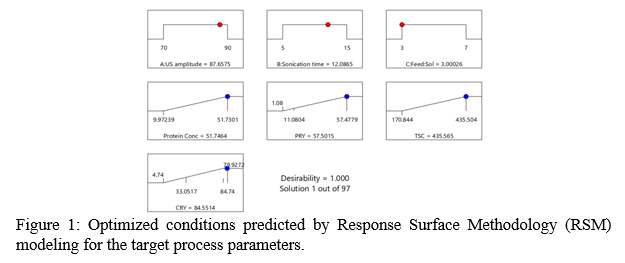OPTIMIZATION AND VALIDATION OF ULTRASOUND-ASSISTED DEEP EUTECTIC SOLVENT EXTRACTION PARAMETERS FOR SEAWEED Saccharina latissima PROTEIN AND POLYSACCHARIDE USING RESPONSE SURFACE METHODOLOGY (RSM)
Introduction
Seaweeds are evolving as ample and sustainable sources of high-value compounds with prospective applications in food, feed, pharmaceuticals, and cosmetics. Brown seaweed Saccharina latissima is a robust source of proteins and polysaccharides. However, most existing extraction methods often comprise elevated energy input, extended extraction times, and use of hazardous solvents, which can degrade sensitive bioactive and other targeted compounds (Zhang et al., 2020). Deep eutectic solvents (DES), specifically those based on choline chloride and lactic acid, pose a green alternative, with exceptional biodegradability and solvating power (Dai et al., 2013). When combined with ultrasound-assisted extraction (UAE), which boosts mass transfer through cavitation, the process becomes vastly efficient for solute diffusion and cellular disruption (Chemat et al., 2017). This study explored the application of UAE-DES for the co-extraction of proteins and polysaccharides from brown seaweed biomass.
Materials and Methods
Dried, ground S. latissima was pretreated with 80% ethanol to eliminate lipids, phenolics, and pigments, improving extraction accessibility. A DES was prepared using choline chloride and lactic acid (1:2 molar ratio), with 30% water added to lower viscosity and improve extraction efficiency. The mixture was heated at 60 °C to form a homogeneous solution. UAE was performed with a probe sonicator under variable process parameters of amplitude (70%, 80%, 90%), sonication time (5, 10, 15 min), and feed-to-solvent (F:S) ratio (3%, 5%, 7%), optimized with Box-Behnken design. Extracts were analysed for total protein content (TPC), protein recovery yield (PRY), total soluble carbohydrate (TSC), and carbohydrate recovery yield (CRY). Techniques such as FTIR, SEM, and HPLC were applied to characterize the extract’s structural, thermal, and chemical features. Comparative studies were carried out using acidic water (pH 2), ultrasound alone and non-ultrasound methods to determine the competence of DES and UAE.
Results and Discussion
Effect of Ultrasound Amplitude
A clear enhancement in extraction efficiency was observed with increasing amplitude. At 90% amplitude and 5 min sonication, TPC and PRY were significantly higher (729.75 µg/mL and 13.32 mg/g, respectively) compared to 70% amplitude (585.75 µg/mL TPC, 9.97 mg/g PRY). The enhancement is credited to effective cavitation and cell disruption, accelerating solubilization of intracellular compounds (Chemat et al., 2017).
Influence of Sonication Time
Prolonged sonication times increased yield, remarkably at increased amplitudes. At 90% amplitude and 15 min treatment, PRY rose to 15.08 mg/g and CRY to 53.33%. However, overexposure without an optimal F:S ratio could lead to compound degradation, highlighting the necessity for a balanced treatment regime.
Feed-to-Solvent Ratio Effects
At 3% F:S ratio, yields were increased under optimized amplitude and time, with CRY extending 84.25%. Although a lower solvent volume guarantees more intense solute-solvent interaction, optimal extraction was mostly achieved at 5% ratio, where adequate diffusion and solubilization occurred without dilution effects.
Optimization and Predicted Responses
Using response surface methodology (Box-Behnken), the optimal conditions were: 88% amplitude, 12 min sonication, and 3% F:S ratio, yielding predicted responses of TPC: 51.74 mg/g, PRY: 57.50%, TSC: 435.56 mg/g, and CRY: 84.55%. Experimental validation confirmed these trends.
Comparative Efficiency of Extraction Methods
Compared to acidic water extraction and ultrasound extraction alone, UAE-DES demonstrated significantly higher yield and purity. Non-ultrasound DES methods, though more efficient than conventional solvents, were subsidiary to UAE-DES, confirming the interactive benefit of cavitation-enhanced solubilization.
Conclusion
The research confirms UAE-DES as an advanced, efficient, and green method for the co-extraction of polysaccharides and proteins from brown seaweed. The optimized factors led to significantly greater yields and improved purity of extracts associated with the conventional method . The DES system, being biodegradable and tunable, poses a sustainable extraction platform aligned with green chemistry principles. These protein- and polysaccharide-rich extracts display elevated potential for application in aquatic and terrestrial animal feed formulations, as well as in functional foods and nutraceuticals, supporting the valorisation of marine biomass within circular bioeconomy frameworks.
References
- Dai, Y., Van Spronsen , J., Witkamp , G. J., Verpoorte , R., & Choi, Y. H. (2013). Natural deep eutectic solvents as new potential media for green technology. Analytica Chimica Acta , 766, 61–68.
- Chemat , F., Rombaut , N., Meullemiestre , A., Turk, M., Perino, S., Fabiano-Tixier, A. S., & Abert-Vian, M. (2017). Review of green food processing techniques. Innovative Food Science & Emerging Technologies , 41, 357–377.
- Zhang, Q. W., Lin, L. G., & Ye, W. C. (2020). Techniques for extraction and isolation of natural products: a comprehensive review. Chinese Medicine , 13, 20.
